In order to mix tracks and instruments properly, you need to understand what is an audio EQ and how an equalizer works.
With an equalizer, you can make instruments better sounding, and cleaner and they will sit better in the whole mix.
There are different types of EQs and they come in different formats. Every EQ works the same way but some of them offer more features and some equalizers are simpler.
After you read this guide, you will have a good understanding of EQ, how it works, and what impact it has on tracks.
What Is An Audio EQ?
An audio EQ is a mixing tool that allows you to cut or boost specific frequencies of any type of audio signal. The equalizer has several controls to manipulate the signal and make it cleaner. You can remove unwanted frequencies and boost the good frequencies.
An equalizer is one of the main tools during the mixing process. Without EQ, it isn’t possible to create clean and good mixes and songs. Every song you know and love is mixed and it uses some kind of EQ.
However, to properly use it, you have to know how EQ works and what it does to sound. If you don’t know how to use EQ, you won’t be able to make great songs.
There are many different types of EQ. Every equalizer does the same job but there are differences in options and features. We will discuss everything about EQ in this guide.
How Does EQ Work?
Audio EQ helps you to remove or boost the frequencies of an audio signal. It has several controls that help you to cut unwanted, unusable frequencies. At the same time, you can boost good frequencies of the audio signal.
You create points on the frequency range, called bands. You choose the desired frequency and you cut or boost them. You can control the amount of boost or cut. Many EQ plugins allow you to create unlimited bands, but some of them have a specific amount of bands.
Many beginners think that EQ can change the sound, and make a bad-sounding instrument better. But that’s not true. You don’t change the source sound.
You just fix it by removing or increasing frequencies. So, the sound is the same but has some frequencies boosted and some removed or smoothened.
When you see the terms cut and boost it means that you remove or increase a specific frequency.

EQ is a very important tool and it can be used on every track. You can use it on guitars, drums, bass, vocals, piano, and so on. But not every track needs it.
Each instrument occupies a particular section in the frequency range. Humans can hear between 20Hz and 20kHz. Instruments such as bass and kick drum, occupy low frequencies, cymbals occupy the section in high frequencies, and guitars mostly are in the mid-range.
So, there is frequency overlap between different instruments. When two instruments are in the same frequency range, for example, a bass guitar and a kick drum, they are struggling for the same frequencies.
Because of that, you can’t hear them well. Our ears can’t distinguish two instruments in the same range.
And that’s why you need EQ. You can remove some frequencies from one instrument and leave a space for another instrument. No, our ears can separate two sounds from each other and we clearly hear bass guitar and kick drum.
The goal of using EQ is to separate different instruments and distribute them across the frequency spectrum. Everything should fit. EQ doesn’t change the sound, it tries to fill the spectrum without any frequency overlapping.
An equalizer, in addition to a compressor, is the most important tool in mixing. It requires knowledge and understanding to properly use it.
EQ Controls
Every equalizer gives you a set of controls to boost or cut specific frequencies. There are three main controls that every EQ has: frequency, gain, and bandwidth a.k.a Q controls.
Also, it can have other additional controls but these three are the main ones. You can create points on the spectrum and start tweaking with these controls.
You can manipulate a wide range of frequencies at once or narrow it down. Also, you can control the number of cuts and boosts.
Let’s discuss the most important controls and options of audio EQ. It’s important to understand how EQ controls work and what impact they have on the sound.
Frequency
With frequency control, you are choosing the specific frequency on the spectrum you want to cut or boost. You create a band and pick the frequency between 20Hz and 20kHz.
Some EQ plugins have faders and some of them have a rotating knob to control and pick frequencies. Also, you can specifically choose the exact frequency by typing it.

Also, modern EQ plugins have a visual display of the frequency spectrum and you can see visually what frequency you are choosing.
But if you are using analog EQ or plugins that are based on an outboard equalizer, you just have a knob and numbers. You have to trust your ears when you use analog or parametric EQ.
And that’s the only thing a frequency control does. You are just creating a band and choosing the specific frequency point.
Gain
The next control of an audio EQ is the gain knob. This controls the amount of gain you want to cut or boost the frequency. Gain can be positive or negative. It’s measured in decibels.
For example, if you want to boost a frequency, then you increase the gain. But if you want to cut the frequency, you decrease the gain.
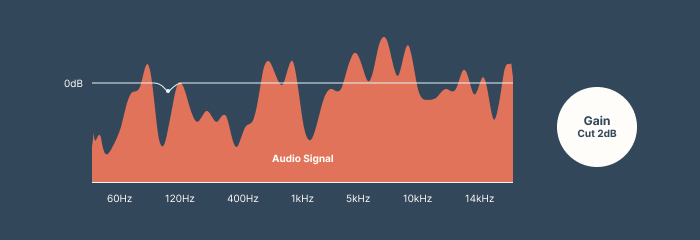
But as you increase or decrease the gain, it has an impact on the output volume. For example, if you cut 2dB of a frequency, it means that the output signal will be lower by 2dB than it was before.
So, you need to control your output volume. Every EQ device has an output volume knob. Or some of them have a separate control for it. The goal is that the input and output must be the same as it was before you applied any EQ.
In a nutshell, the gain control in EQ is the tool to choose the cutting or boosting amount in decibels. It doesn’t change the sound. Just boosting or cutting specific frequencies.
Bandwidth
Bandwidth sometimes referred to as Q, is a control that handles the shape of the EQ curve. When you cut or boost frequency, the shape of the band could be wide or narrow. That’s what Q or bandwidth does.
The wider the curve is, it covers more frequencies. But you can create a very narrow shape that will only cover a small amount of frequency. So, when you cut or boost, not only you can choose the amount, but the shape too.
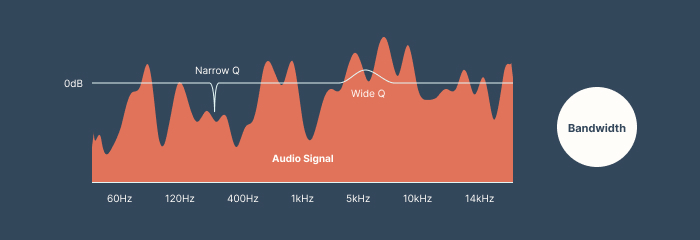
In general, it’s a good practice to have narrow EQ bands when cutting and wide EQ bands when boosting. Because when a source sound is good, you don’t want to cut too much frequency.
Your goal is to remove unnecessary and bad frequencies. On the other hand, when you boost a frequency because it sounds good, it’s better to have a wider band to have more good frequencies boosted.
HPF and LPF
Last but not least feature is the EQ pass filters. There are two types of pass filters – high pass filter (HPF) and low pass filter (LPF). Sometimes they are referred to as a low cut and high cut.
Low pass a.k.a high cut is when you cut the high frequency with a curved band. And high pass a.k.a low cut is the opposite – you cut low frequencies and let the high frequencies pass.
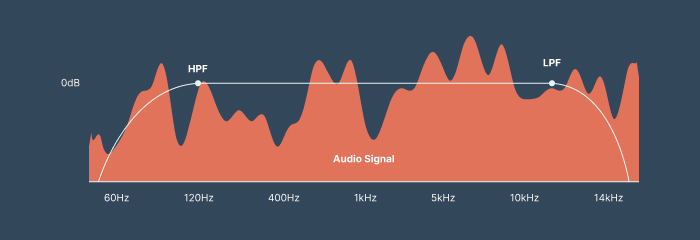
Some EQ plugins have separate controls for HPF and LPF. But you can create a simple EQ band and give it the shape of low cut or high cut. The goal of these filters is to remove very low and high frequencies.
Low-cut and high-cut filters are used all the time and they are very handy. Because the very lows and very highs are not needed the most times, you can remove them with HPF and LPF easily.
Like other EQ bands, you can control the frequency, amount, and curve of pass filters with the same EQ controls.
Types of EQ
Now that you have a good understanding of EQ and how it works, it’s time to learn more about different types of audio EQ.
There are many different kinds of equalizers you can find. Like many audio devices, there are analog EQs and equalizers in a VST plugin format.
But the most important thing is to know the types of EQ. These different EQs offer various features some of them are simple and some have too many options.
Let’s discuss the three most popular types of audio equalizers.
Parametric EQ

Parametric EQs are the most flexible ones. Especially modern equalizers in VST plugin format. You can control everything with surgical accuracy. Also, they have awesome visuals that make working with it easier.
With parametric EQs, you can choose any frequency you want, create as many bands as you want, pick different shapes of curves, etc. But also there are EQs that offer a specific number of bands.
But in general, parametric EQs are easier to use, have great features, and are the best type of EQs for beginners. One of the most popular parametric EQs is FabFilter.
Graphic EQ
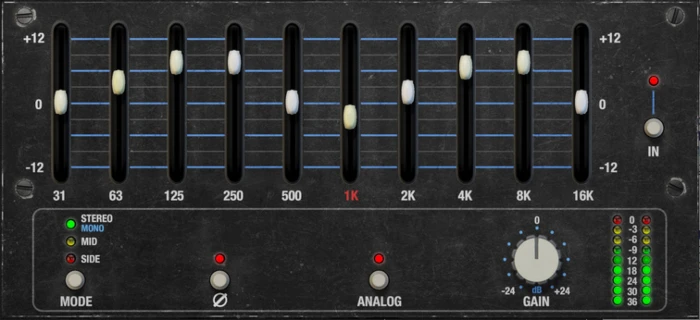
Graphic EQs are also a great type of audio EQ but have some limited features. In most cases, you can only manipulate the set of frequencies the device offers. These EQs offer a set of frequencies you can cut or boost with a fader.
Some of the graphic EQs have options for bandwidth, HPF, and LPF, but most of them are very minimalistic. Several graphic EQ plugins offer a visual presentation of the frequency spectrum.
Graphic EQ is for more advanced mixing engineers and you rely on your ears. You need to have some experience before starting to use it.
Dynamic EQ
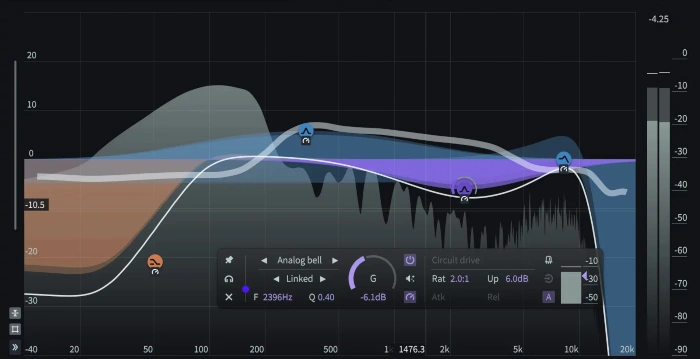
A very special equalizer is a dynamic EQ. It’s a more modern approach to EQs and has really great features. With dynamic EQs, you can do much more than with regular equalizers.
Dynamic EQs are like parametric EQs but have one special feature. You can control the band and tell it when it should turn on. In other words, it needs a trigger to start working.
For example, you want to cut around 120Hz but only when the sound exceeds -3dB. You can do it with dynamic EQ. The equalizer won’t cut that frequency until the sound goes above -3dB.
Also, you can use sidechaining with dynamic EQs and the trigger will be the other source of the sound. For example, you can cut a specific frequency of a kick drum only when the bass guitar plays and overlaps the same frequency.
Dynamic EQs are really great and advanced tools to mix your songs. Many modern parametric EQs have this feature built-in.
Conclusion
Understanding what an audio EQ is and how it works is critical. Every mixing engineer has to have a good understanding and knowledge of equalizers. When you know how it works, it will make the mixing easier and a better experience.
Today we have many great free and premium EQs that offer many features. And sometimes it can be overwhelming. So, to use them properly to make better mixes, it’s crucial to have a good understanding of how EQs work.
